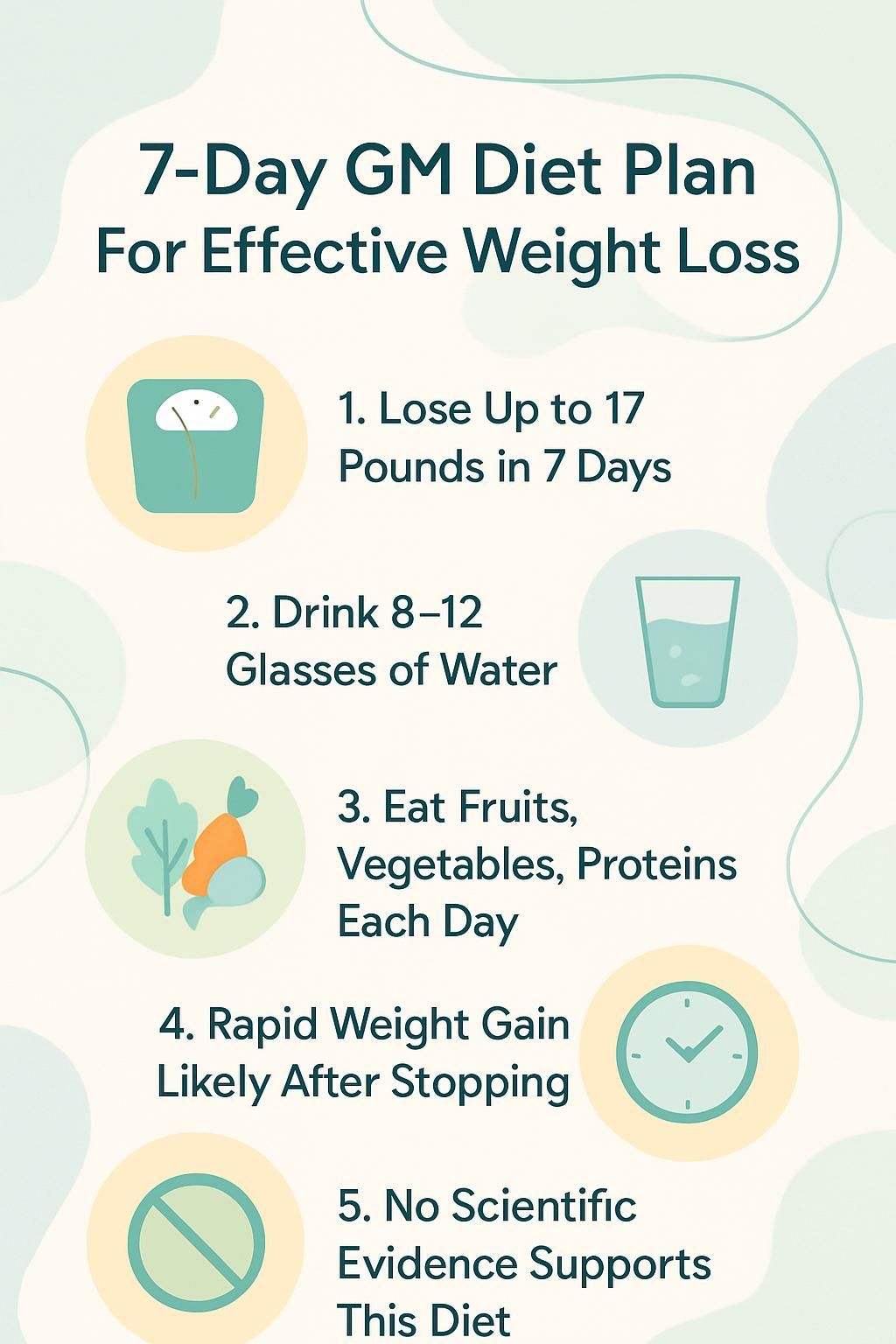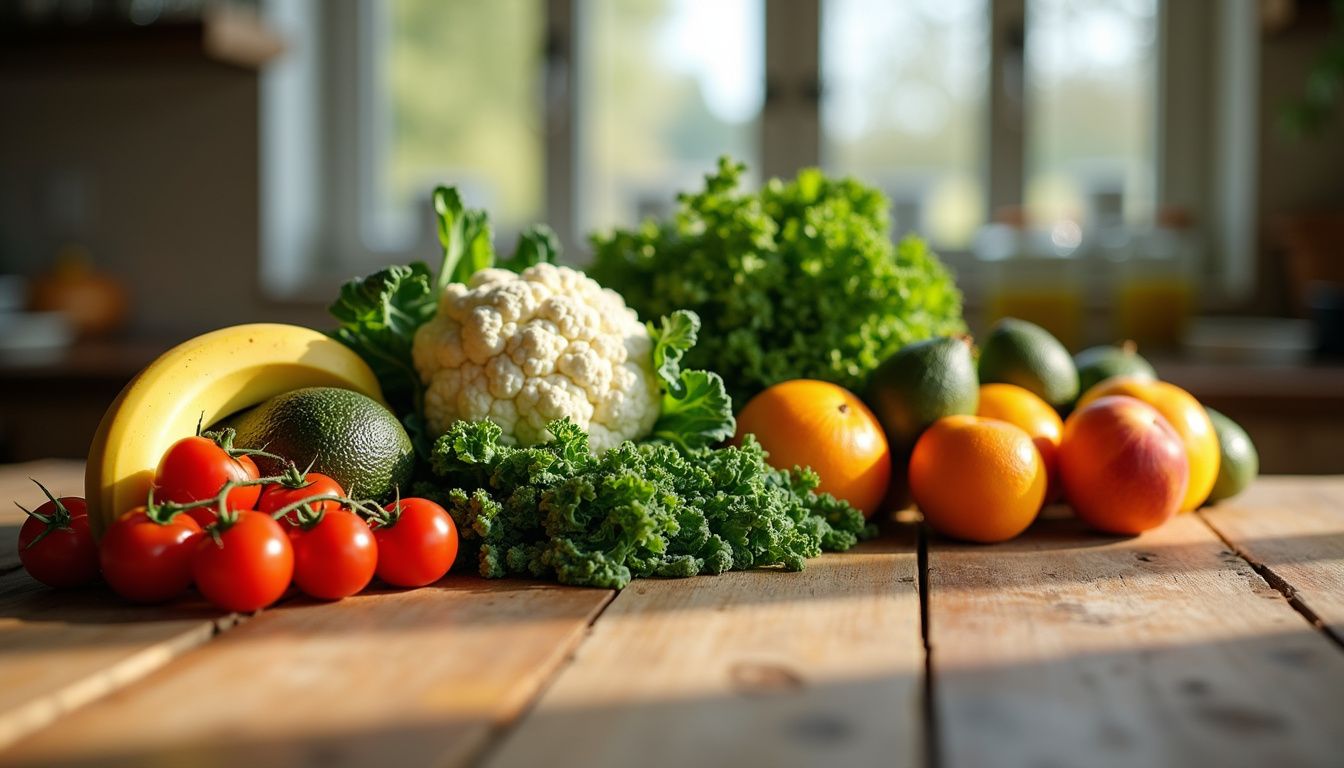7-Day GM Diet Plan For Effective Weight Loss
Our Nutrition Assistant AI Suite will transform your body. You will lose fat, get toned, and build muscle. Gain confidence and optimal health.
If other diet plans have stalled, the GM Diet Plan promises quick results. It claims you can lose up to 10 to 17 pounds in seven days by following a strict 7-day structure.
In this guide, you will learn what the GM Diet is, how each day works, and who should avoid it. You will also see the pros, the cons, and safer ways to use this short plan to support weight loss.
Key Takeaways
- The 7-day GM Diet, widely shared since 1985, claims 10 to 17 pounds of weight loss in one week through strict daily food rules.
- It creates a calorie deficit, which means you eat fewer calories than you burn. The plan uses fruits, vegetables, protein or brown rice on specific days, and 8 to 12 glasses of water.
- Most early weight loss comes from water and glycogen, the stored form of carbohydrate, not body fat. Many people regain the weight once normal eating returns.
- No strong clinical trials support the GM Diet’s safety or long-term results. Experts warn about nutrient gaps and added risk for people with diabetes, heart disease, or during pregnancy (Gupta et al., iLIVER, 2023).
- Medical guidance is wise before starting. Reported side effects include fatigue, headaches, low energy, and possible muscle loss, especially with repeat cycles.

Overview of the GM Diet Plan

The GM Diet Plan is a seven-day program built to trigger rapid weight loss through a tight calorie limit. It centers on fruits, vegetables, water, and selected protein or brown rice on set days.
Where Did the GM Diet Originate?
The diet is often linked to General Motors in 1985, though the exact origin is debated. Some stories mention help from the USDA and FDA, and testing through Johns Hopkins Research Center, yet these claims have been challenged over time.
General Motors Corp.’s Board of Directors reportedly approved the plan on August 15, 1985. Many versions now exist, but the daily structure remains similar, rotating fruits, vegetables, and protein sources.
I once tried a workplace version years ago. The rules were simple to follow, but details varied between handouts, which is common with this plan.
How Does the GM Diet Work?
The plan assigns food groups by day to create a calorie deficit. A calorie deficit means you take in fewer calories than you use, so your body taps stored energy.
Early days emphasize fruits and vegetables. Later days add protein or brown rice. Alcohol is discouraged. Exercise is limited at first, then light activity like walking or yoga is allowed.
Supporters say water-rich produce, such as tomatoes and cabbage, reduces water retention. They also claim some foods are “negative-calorie,” suggesting digestion uses more energy than the food provides. This idea is popular online but not supported by strong evidence.
Glycogen, your body’s stored carbohydrate, drops with lower carb intake. This leads to water loss, which can show fast changes on the scale during the 7-day GM Diet.
“The GM diet encourages you to eat specific foods to boost fat loss and may help shed pounds quickly, but it can feel strict and tough for some.”
What Are the Benefits of the GM Diet?
People try the GM Diet to see quick progress. The strict daily structure can give a short burst of motivation and a simple weekly plan to follow.
How Does the GM Diet Promote Rapid Weight Loss?
The plan is low in calories and big on water-rich foods, which helps you eat less without feeling empty at first. Many report 4.4 to 11 pounds lost in a week, and some claim more.
Much of this change comes from water and glycogen loss, not true fat loss. Water helps flush excess sodium, which reduces bloating. The scale moves fast, but the body fat change is usually small.
Results are often temporary. Once regular eating resumes, weight tends to return if habits do not change.
Why Does the GM Diet Increase Fruits and Vegetables Intake?
Several days allow unlimited fruits and vegetables. These foods are low in calories and high in fiber. Fiber supports digestion and helps you feel full longer.
They also contain a lot of water, which supports hydration. A large 2015 study of more than 133,000 people linked higher produce intake with less weight gain over four years. The idea of “negative-calorie” foods, such as celery, is catchy, but research does not confirm it.
Filling your plate with fruits and vegetables each day can make a real difference in your journey for healthy weight loss.
What Detoxification Benefits Does the GM Diet Offer?
Processed foods are cut for a week. That means far less added sugar, sodium, and refined fats. Many people also drink more water, which increases urine output and reduces puffiness.
Watermelon, cucumber, and tomato are natural diuretics, meaning they help the body release water. GM Wonder Soup adds fluids and fiber. Cabbage, bell pepper, onion, carrot, and tomato bring vitamins with very few calories.
During my week on a similar meal plan, I visited the restroom more often by day two. I felt lighter, mostly from less salt and more fluids.
Summary: fewer processed foods, more fluids, and more produce. These shifts may help you feel less bloated, though detox claims are not firmly proven by research.
How Does the GM Diet Improve Digestion?
Several days emphasize fiber-rich fruits and vegetables. Fiber helps keep bowel movements regular and may ease constipation.
The plan skips beans early in the week. Some people find legumes harder to digest. Wonder Soup features gentle vegetables like cabbage and celery, which many tolerate well.
Many users report less bloating by week’s end due to the simple menu and higher fiber.
What Are the Risks and Drawbacks of the GM Diet?
This short, strict plan can carry trade-offs. Knowing the risks helps you decide if it fits your situation.
Does the GM Diet Lack Essential Nutrients?
Most days limit protein, healthy fats, or both. That can reduce iron, calcium, vitamin B12, and omega-3 intake. Day 1 is only fruit. Day 2 is only vegetables. Day 3 is a mix, which still may not meet protein needs.
Even on the high-protein days, overall intake may be low for long-term health. Repeating the plan often raises the chance of nutrient gaps.
When I sampled a few days, my energy dipped and strength workouts suffered. Balanced diets that include all food groups support better results over time.
Is Weight Loss from the GM Diet Temporary?
People often lose 2 to 5 kg in a week. Most of that is water, not fat. After the plan, weight commonly rebounds once normal meals return.
The GM Diet acts like a crash diet. It restricts calories hard, but it does not teach sustainable habits. For lasting results, a balanced diet plus regular activity works better than repeated seven-day cycles.
What Are the Potential Side Effects?
Hunger, headaches, low energy, and trouble focusing are common, especially in the first days. Day 4, with bananas and milk, can feel especially tough.
On my first try, I felt lightheaded by lunch and cut my afternoon plans short. Repeating strict cycles can raise the risk of muscle loss and nutrient gaps.
People with diabetes or thyroid disease should avoid the plan unless a clinician is monitoring them. Blood sugar and hormones can shift quickly with sharp calorie cuts.
Detailed 7-Day GM Diet Plan
This outline shows what the diet includes each day. It gives structure, but it is strict.
What to Eat on Day 1: Fruit Diet
Eat only fruit, any type except bananas. Watermelon and cantaloupe are popular because they are filling and hydrating.
Drink 8 to 12 glasses of water. You may have plain black coffee or plain green tea, but skip sugar and cream. No juice, honey, or dairy.
Some report up to 3 pounds lost by the end of Day 1, mostly from water changes.
What to Eat on Day 2: Vegetable Diet
Eat only vegetables, raw or cooked. Good options include spinach, carrots, broccoli, cabbage, and zucchini.
Breakfast includes one large boiled potato with a small amount of butter or oil. Skip corn and peas, which are higher glycemic. Limit cooking oil to 1 teaspoon for the whole day.
No fruit or sugar substitutes. Drink 8 to 12 glasses of water. Large servings are allowed to meet hunger.
What to Eat on Day 3: Fruit and Vegetable Diet
Mix fruits and vegetables, but avoid bananas and potatoes. Aim for color and variety to bring different nutrients and fiber.
Drink 8 to 12 glasses of water. Many people enjoy mixed salads, steamed vegetables, and the GM Wonder Soup to manage appetite.
What to Eat on Day 4: Bananas and Milk Diet
Eat up to 6 large bananas or 8 small ones. Drink up to 3 glasses of skim or low-fat milk.
Wonder Soup is allowed for variety. Avoid other foods, including meat, grains, or extra produce. On my Day 4, bananas were filling, but I added soup at lunch to feel satisfied.
What to Eat on Day 5: Protein-Rich Diet (Meat or Alternatives)
Eat two 10-ounce portions of beef, chicken, or fish, paired with six whole tomatoes across the day. Vegetarians can use brown rice or cottage cheese instead, still two portions total.
Increase water intake by about two extra glasses to help clear uric acid, which forms during protein breakdown.
Limit your choices to the plan for Day 5. This helps control calories while bringing back protein for satiety.
What to Eat on Day 6: Protein and Vegetables
Combine lean protein and vegetables. Skip potatoes. Meat eaters can choose baked chicken or lean beef. Vegetarians can use cottage cheese or brown rice.
Enjoy tomatoes freely. Drink at least two extra glasses of water. I found this day steadier for energy, thanks to protein plus fiber.
What to Eat on Day 7: Brown Rice, Fruits, and Vegetable Juice
Eat brown rice, fruits, and vegetables in generous amounts. Vegetable juice is allowed without added sugar or sweeteners. No meat, dairy, or potatoes.
Brown rice offers complex carbohydrates, which digest slowly and help steady blood sugar. Keep water at 8 to 12 glasses to support hydration.
Many people pair brown rice with berries at breakfast, then add vegetable juice at lunch to stay on track.
GM Wonder Soup: A Core Component
Wonder Soup is a low-calorie staple in the GM Diet. It helps curb hunger between meals and adds hydration.
What Are the Ingredients of Wonder Soup?
Gather these items:
- 6 large onions
- 2 green bell peppers
- Whole tomatoes
- 1 head of cabbage
- 1 bunch of celery
- 28 ounces of water
- 4 envelopes of Lipton onion soup mix
Optional herbs and spices can boost flavor. During my week, the soup helped me stay full with very few calories.
How Do You Prepare Wonder Soup?
Place all vegetables and water into a large pot. Add the onion soup mix and any seasonings you prefer.
Bring to a gentle boil, then simmer until tender, about 30 to 40 minutes. Most people eat two to three bowls per day during the 7-day GM Diet.
Cooking a big batch ahead of time makes it easier to follow the plan during busy days.
What Are the Benefits of Including Wonder Soup?
Wonder Soup offers volume, fluids, and fiber for very few calories. It can reduce cravings and provide vitamins and minerals from different vegetables.
During my week, a hot bowl between meals helped me avoid off-plan snacks. It fits the low-calorie structure and supports appetite control.
For many, Wonder Soup is the linchpin that keeps the plan doable.
Sample GM Diet Plan Menu
Use this sample menu to plan your week and reduce guesswork. Adjust portions to hunger within the allowed foods for each day.
What Are Day-by-Day Meal Suggestions?
- Day 1: Breakfast, watermelon. Lunch, cantaloupe. Snacks, apples or oranges. Dinner, pineapple or berries.
- Day 2: Breakfast, boiled potato with a small amount of butter. Lunch, mixed green salad. Dinner, steamed broccoli and carrots.
- Day 3: Breakfast, watermelon. Lunch, mixed vegetable salad. Dinner, fruit salad. No bananas or potatoes.
- Day 4: Each meal, two bananas and one glass of milk. Add Wonder Soup if needed.
- Day 5: Breakfast, grilled chicken and two tomatoes. Lunch, five ounces of beef and two tomatoes. Dinner, repeat protein and tomatoes.
- Day 6: Breakfast, grilled fish with spinach. Lunch, lean beef stew with vegetables. Dinner, chicken with mixed vegetables.
- Day 7: Breakfast, brown rice with mixed fruit. Lunch, vegetable juice with brown rice. Dinner, brown rice with steamed vegetables.
Sticking to clear choices helped me avoid cravings and focus on the week’s goal.
How Can You Stay on Track with the GM Diet?
- Drink 8 to 12 glasses of water daily. On protein days, add two extra glasses.
- Cook a large pot of Wonder Soup before Day 1.
- Plan meals one day ahead. Keep allowed foods visible and ready.
- Avoid alcohol, beans, and sugary drinks, which are off-plan.
- Use vegetarian swaps like cottage cheese if you do not eat meat.
- Track progress with a journal or app for added motivation.
These steps make the GM Diet simpler to follow and reduce the chance of rebound choices.
Does the GM Diet Work?
Results vary. Some see fast losses in a week, yet research does not show lasting effects.
What Scientific Evidence Supports the GM Diet?
There are no high-quality clinical trials proving the GM Diet works for long-term weight control. A 2023 review by Gupta and colleagues in iLIVER discussed the GM Diet as a quick fix for liver donors. The authors found weak evidence for safety and sustained results.
Claims about negative-calorie foods remain unproven. In my trial, weight dropped in a few days, then stabilized once regular food returned.
What Do User Testimonials Say About the GM Diet?
Many people share quick drops of 10 to 17 pounds in a week. Posts often include before and after photos and daily logs.
Some report weight returning shortly after the plan. Common complaints include hunger, headaches, and low energy. My experience matched many posts, with fast early changes and rising hunger on midweek days.
Who Should Avoid the GM Diet?
This plan is not right for everyone. For some health conditions, it can raise risks.
What Health Conditions Make the GM Diet Risky?
People with diabetes can face blood sugar swings due to rapid carb changes. Those with hypothyroidism may see symptoms worsen with strict calorie cuts.
Heart and kidney conditions require steady intake of protein, minerals, and fluids, which the plan may not provide. Anyone with a history of eating disorders should avoid restrictive plans that can trigger relapse.
When I tried the plan, I felt weak by day three and needed extra rest after the week ended.
When Should You Consult a Doctor Before Starting?
Talk with a clinician if you have any chronic condition or take daily medication. People with thyroid issues or diabetes need monitoring for safety.
Pregnant or breastfeeding women should skip restrictive plans. If you worry about missing nutrients, ask your provider about safer options and timing.
How Can You Follow the GM Diet Successfully?
Good planning and steady hydration make this strict plan easier to manage for one week.
Why Is Staying Hydrated Important?
Drink 8 to 12 glasses of water daily. On Days 5 and 6, add about two more glasses. Water supports digestion and helps reduce bloating as your carb intake changes.
Aim for plain water, club soda, black coffee, or unsweetened tea. Skipping alcohol is part of the plan. During my week, steady water intake helped with focus and reduced snack urges.
How Can You Prepare Meals in Advance?
Cook Wonder Soup in bulk before Day 1. Wash and cut fruits and vegetables the night before. Store in airtight containers for easy access.
Cook brown rice ahead for Day 7 and protein days if you use it as a vegetarian option. Keep oil to 1 teaspoon on vegetable days.
Stock your fridge with allowed beverages to avoid last-minute cravings.
How Do You Manage Cravings on the GM Diet?
Use Wonder Soup whenever hunger ramps up. It provides volume and warmth without many calories.
Drink water or herbal tea between meals. On produce days, keep cut-up watermelon, cucumber, carrots, or apple slices ready. Avoid sugar, beans, and sweetened drinks, which are off-plan and can derail progress.
What Are the Long-Term Implications of the GM Diet?
Short plans can kickstart change, but long-term success depends on daily habits you can keep.
Why Is the GM Diet Not a Sustainable Solution?
The GM Diet is a short, restrictive plan. Most early losses are water, and weight often returns after the week.
Repeating strict cycles can slow progress, lower muscle mass, and weaken motivation. Sustainable weight loss relies on balanced eating and consistent movement, not repeated crash cycles.
Why Is Balanced Nutrition Important After the GM Diet?
The plan can underdeliver protein, healthy fats, and key vitamins. After seven days, shift to balanced meals that include lean protein, whole grains, healthy fats, fruits, and vegetables.
Enough protein helps preserve muscle and steady appetite. If you need support, meet with a registered dietitian to build a plan that fits your health and routine.
Conclusion
The 7-day GM Diet offers a fast, structured approach to weight loss. It uses set food groups and high water intake to drive quick changes on the scale.
Still, evidence for long-term success is weak, and the plan can miss essential nutrients. Side effects like hunger and low energy are common, and weight regain is likely.
If you try the GM Diet Plan, use it as a short reset, then move to a balanced diet for sustainable weight loss. Check with a healthcare professional first, especially if you have a medical condition or take daily medication.
FAQs
1. What is the 7-Day GM Diet Plan and how does it help with weight loss?
The 7-Day GM Diet Plan is a structured eating program that focuses on specific food groups each day to promote calorie reduction and fat loss. Research shows that calorie restriction and increased fruit and vegetable intake can support short-term weight loss (Smith et al., 2019). Many people report losing several pounds in one week by following this plan.
2. Is the GM Diet Plan safe for everyone?
The GM Diet Plan is not suitable for children, pregnant women, or people with certain health conditions such as diabetes or kidney disease (Mayo Clinic, 2022). Consulting a healthcare provider before starting any restrictive diet is important for safety.
3. What foods are included in the GM Diet Plan?
The plan includes fruits, vegetables, lean meats, and brown rice on specific days. For example, the first day focuses on fruits, while the second day emphasizes vegetables. This rotation aims to provide nutrients while limiting calories.
4. Can you keep the weight off after finishing the GM Diet Plan?
Most people regain some weight after returning to regular eating habits. Studies suggest that long-term weight loss requires ongoing healthy eating and regular physical activity (CDC, 2023). My own experience showed that while I lost weight quickly, maintaining it required lasting changes in my daily routine.
Summary:
The GM Diet Plan offers a short-term approach for effective weight loss by guiding food choices each day. It is not suitable for everyone and may not support long-term results without continued lifestyle changes. Always seek professional advice before starting any new diet plan.







